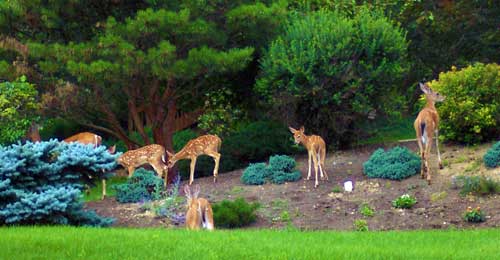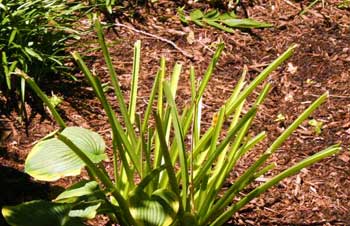Hungry deer are devouring Hostas and more
Deer browsing seems to be a big problem this summer. Consider these tips for preventing deer damage to your landscape.
A desperate request came from Master Gardener Linda Blanco earlier this week: “Please write an article on deer browsing – they are eating everything this year.” We don’t know if this is because we have more deer now, or if it is because wild vegetation is so dry and brown, but in any case, deer browsing seems to be a big problem so far this summer (Photo 1).

Photo 1. Deer browsing on vegetation. Photo credit: Ohio Gardener Newsletter
Browsing on trees and shrubs like arborvitae is well-known to most people because the damage is limited to how high the deer can reach and leaves an obvious, deer-pruning pattern where all the foliage below a height of 4 to 5 feet is gone (Photo 2). But, complaints are coming in about deer browsing on a wide variety of garden and yard plants, especially Hostas. Deer seem to prefer Hostas over many plants and may selectively feed on it. Look for plants with most of the leaves chewed off right to the stem (Photos 3 and 4).

Photo 2. Foliage below 4 to 5 feet is gone due to deer.


Photos 3 and 4. Plants with most of their leaves chewed off to the stem is a sign of deer browsing.
Preventing deer damage can be accomplished with netting that covers plants or with chicken wire placed over the ground so that the deer must step on it to reach the favored plants. The easiest way, however, is to offend their keen sense of smell and taste. Purchase one of the deer repellant products at your local garden center. Please note that these products are made to smell awful and may contain garlic or hot pepper extract, so wear gloves and long sleeves and avoid inhalation when spraying. Be prepared to strip your clothes and wash immediately afterwards. Most of these products work very well when applied frequently.
When product failures are investigated, the failure is usually because the homeowner did not apply the product frequently enough. With lots of deer activity you may need to spray once per week or once every two weeks. After a heavy rain, be prepared to spray again. Also, daily irrigation may wash away most of the spray residue. If put your nose close to the plant or ground and cannot smell the deer repellent, you need to spray again. Please note that the deer repellents may damage some plants when sprayed onto the foliage. They work just as well when sprayed on the ground around plants, especially if there is mulch on the ground because it will absorb some of the spray. For best results, spray the perimeter around flower beds and gardens with plants that deer like. How do I know? Well, lets’ just say some of the photos in this article could have been taken at my house.
Dr. Smitley’s work is funded in part by MSU’s AgBioResearch.



 Print
Print Email
Email

